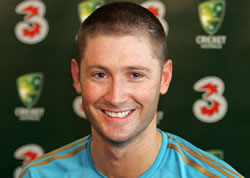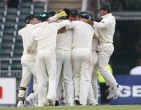Australia and T20
Corey Taylor |
The Australian cricket hierarchy still appear unable to take T20 cricket seriously. The topic has been discussed here before and it, on the face of it, progress from that point is still some time away. The recent appointment of Michael Clarke as captain of Australia’s international T20 captain speaks volumes of their selectorial approach in that, again, T20 is looked upon as little more than experience which is used to further a Test career. Tests should remain the pre-eminent form of the game in this country but the message repeated here before remains the same; such an important international team should not be taking T20 so lightly.
It’s also true that limited overs internationals are, always have and seemingly always will, be treated as trials for the Test side in Australia. All indications are that this is a hang-over from the coaching and selection philosophy of Bobby Simpson. The seminal moment for nearly 20 years of subsequent success has always been identified as the World Cup win in 1987. However, Test success was always the goal with a World Cup win the vehicle towards being the best Test side in the world and the players selected accordingly. It’s no coincidence that several players from previous successful World Cup campaigns were subsequently selected for or recalled to the Test side soon afterwards.
A recent interview with Simpson by Sportstar Weekly confirms the somewhat anachronistic attitudes towards the shorter forms of the game.
“[Players] need to play Twenty20 cricket, which is the most boring of all forms. While I like and enjoy it, it’s a bit like one-day cricket. If you don’t get a close finish, what have you got? A very ordinary game of cricket. Now you are going to get more ordinary games in Twenty20 purely because the players would be going out so hard early on and we will see a lot of collapses. It doesn’t give you enough time to rebuild.”
The problem with this attitude is that it’s based in the early form of T20, where the game was looked upon as little more than an exhibition game, a match for players to have some fun with little else attached to it. With every passing tournament, teams do much to prove confound these thoughts by taking the competitions deadly seriously. The slog-fest mentality is also a relic of the past as teams may still lose early wickets but are better at recovering to either win or at least give the opposition an almighty scare. Teams losing four or more quick wickets then just playing out their overs are becoming far less common. The game is almost never dead anymore.
The lack of evolution of opinion is problematic for many reasons and goes to the heart of Australia’s cricketing psyche. To play for Australia at any level, a player serves his interests well if he expresses a desire to make the highest level available at the club. Imagine, if you will, the gnashing of teeth in this country if a first-class player’s stated aim wasn’t to make the Test side or if they didn’t say at least once with a dreamy look in their eyes “Yeah, always been my dream as a kid to wear the baggy green.”
The problem is, there are only eleven Test spots. So you have several groups of players for whom playing Test cricket is either out of reach or dependent on injuries. If you’re good enough to make the Test side and want to play Test cricket, you have to bide your time in the one-day sides and keep scoring runs in Sheffield Shield cricket to continue being selected. If you’re not quite good enough to play Tests but still express that you’d love to play Test cricket, same deal. The thing is, if everyone above you is saying “unless it’s Tests, it means nothing” or fobbing you off with “Look, keep at it, a spot might open up in the Test side, you never know”, perhaps you’d decide that if you’re going to play meaningless cricket, you may as well go play meaningless cricket for a ton of money and make your life a bit beyond merely comfortable. Either way, you have some options, even if they’re not really what you’d like.
Then there are the players for whom Test cricket might not be a possibility or even that desirable. It seems to be the case that if you take a more pragmatic approach to your career and decide it’s not worth it to ‘pay your dues’ for years, with little to no prospect of reward, or decide it’s not likely to happen soon, none of the above options would even be available to you. You simply won’t get a T20 or one-day spot because they’re already taken by blokes looking to crack the Test side. So to hang onto an international spot, you’d better say you have Test ambitions.
This goes some way to explaining why guys like Dirk Nannes and Brad Hodge are anathema to Australian selectors and why they’re over-looked for all forms of the game. Generally-speaking, they’re out of Test contention and, by some indications, aren’t terribly fussed about it, now looking to make a good living from their sport. So they don’t get a look-in for any of the teams. The problem? You don’t have the best players making up the best possible team. This doesn’t appear to be a problem for the Australia selectors; as long as Test cricket is healthy, sacrificing a few tournaments along the way to Test success won’t matter. Right?
Each of those groups of players is subject to a talent drain towards very lucrative IPL contracts with many more options in other countries likely to present themselves soon. These fears have been raised on numerous occasions but they’ve not really materialised yet. Partly this is explained by spots being available in the Test side at various times owing to poor form o injury as Australia looks to re-build it’s Test side. However, had the IPL been around during the 90’s, it would have provoked some serious thought for players like Darren Lehmann, Stuart Law, Jamie Cox, Brad Hodge, Matthew Hayden and all the other players who were outside of Test reckoning for so long. The advice to “hold on, you’ll get a spot once an injury comes up. Just keep churning out the runs,” would have worn thin very quickly. With other options now up for grabs, there are many talented players who are gearing their games to make it in T20 because they don’t want to waste their professional lives hoping for something which might not happen anyway.
The options back then to supplement your income were to go play entire off-seasons in England. Now, IPL gives players the opportunity to make far more money in half the time. Tempting if you’ve no great desire to sacrifice long periods away from home to play in a team which doesn’t have the very best available players to play matches against teams with exactly the same problem. For many players, Test cricket is the most desirable form to aim for because it’s the most competitive form of the game, the honour of representing one’s country is great and all but deep down the contest is where it’s at. If the perception that Tests are the highest form of the game was to change, why would players opt to stick with it?
Already it’s possible to make a ton of money from playing cricket but not for your country, Andrew Symonds is an archetypical example; after numerous discipline problems, he can play the game he loves for the teams he chooses to at a very high level, making plenty of cash in the process.
At state level, selection panels have been quick to use T20 specialists but at international level, players with one eye on the Baggy Green have been preferred. Making Michael Clarke captain of the international T20 side, despite being without a T20I half-century to date, is a strong indicator of the selectors’ attitudes at present and his own comments here here do little to assuage concern:
“There have been reasons why I haven’t taken part in the last couple of IPLs,” Clarke told a press conference at the SCG on Monday. “I’ve always said that it’s a competition I would love to take part in at the right time. If the timing is right, if my body is healthy and I’m feeling good and a team wants me, it could be a great opportunity to prepare for what’s going to be a huge Twenty20 World Cup.”
Sure sounds enthusiastic about it, doesn’t he?
Australia has always been comfortable with players being declared Test specialists but, do the same with T20’s/ODI’s and you’re unlikely to make an appearance for those teams. Playing limited-over cricket has to be looked-upon as a legitimate career choice and not just preparation for playing Tests. The current selection policy for the T20 side means disastrous campaigns such as Australia’s T20 World Cup are somewhat inevitable. As embittering as it seems, the Australian cricketing hierarchy needs to come to terms with the fact that there will be players who will want to play for the international T20/ODI sides, and be the best players available, but have less interest in playing Test cricket, preferring to play for an IPL team or similar in between T20I commitments. The situation where players are completely excluded from all international selection because they don’t have Test ambitions has to change or the quality of the pool available for Tests will diminish.





He does add a lot in the field, and potentially bowling-wise too. Not saying he should necessarily be captain, but given time you would think he could be a valuable member of the team. The problem is, even if he’s not playing T20 for Australia that doesn’t mean he’ll play any more domestic T20 as the schedules don’t fit that way. Sure, he could play IPL, but is it a good idea to push such a critical player with a long-standing injury problem into a crazy tournament like that on top of everything else?
Comment by four_or_six | 12:00am GMT 4 November 2009